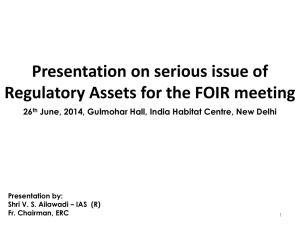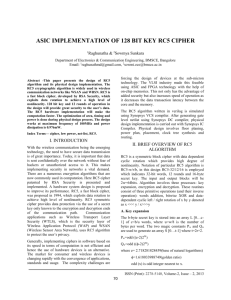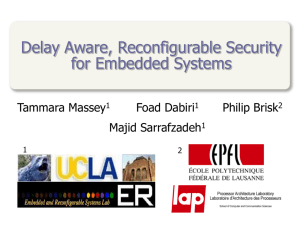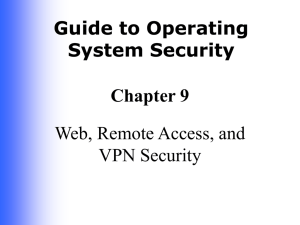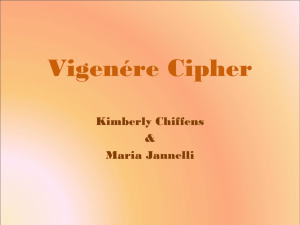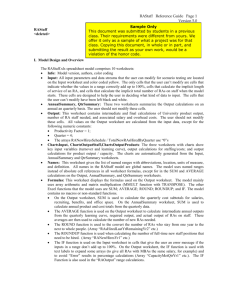presentation
advertisement
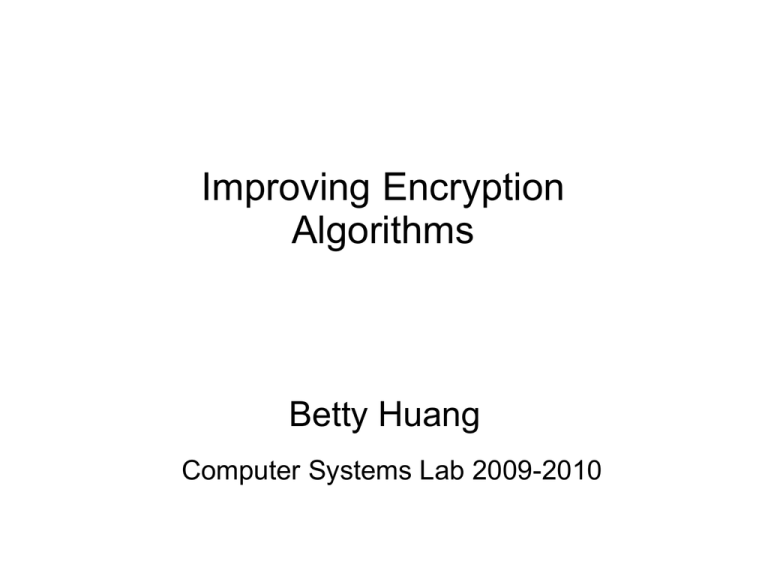
Improving Encryption
Algorithms
Betty Huang
Computer Systems Lab 2009-2010
Abstract
Modern algorithms often employ sophisticated
technology that involve powerful processors,
which require a great deal of effort to break.
During second quarter, I explored cryptanalysis of
various encryption standards, ranging from SHA to
MD5 and finally to RC5. In this quarter, I have
been working on research and implementation of
code that attacks the RC5 encryption algorithm,
and have managed to write a successful"knownplaintext" attack against the RC5.
Background
Purpose of Encryption Algorithms
One-way functions
Hash functions: MD5, SHA family
Block Cipher: DES, Blowfish
Block Ciphers
A block cipher consists of two paired algorithms, one for
encryption, E, and the other for decryption, E-1. Both
algorithms accept two inputs: an input block of size n bits
and a key of size k bits, yielding an n-bit output block. For
any one fixed key, decryption is the inverse function of
encryption, so that
for any block M and key K. M is termed the plaintext and
C the ciphertext.
RC5: Goals
•
symmetric block cipher
•
suitable for hardware or software
•
fast
•
adaptable to processors of different word-lengths
•
iterative
•
variable number of rounds.
•
security
•
variable-length cryptographic key
•
Simple
•
Low memory requirement
•
High security (?)
Features of RC5
•
Data Dependent Rotation - which simply
means that the rotation amounts are random
variables that arise from the input, rather than
predetermined constants.
–
•
Increases security against differential/linear
cryptanalysis
Simplicity – only three operations (XOR,
Notation
1. Two's complement addition of words, denoted by “+". This is modulo-2w
addition. The inverse operation, subtraction, is denoted “-”.
2. Bit-wise exclusive-OR of words, denoted by ⊕.
3. A left-rotation (or “left-spin") of words: the cyclic rotation of word x left by
y bits is denoted x << y. Here y is interpreted modulo w, so that when w is
a power of two, only the lg(w) low-order bits of y are used to determine the
rotation amount. The inverse operation, right-rotation, is denoted x >> y.
RC5 Encryption Algorithm
Development
1. Coding of RC5 (weakened):
…
void RC5_ENCRYPT(WORD *pt, WORD *ct)
{
WORD i, A=pt[0]+S[0], B=pt[1]+S[1];
for (i=1; i<=r; i++) {
A = (A^B)+S[2*i];
B = (B^A)+S[2*i+1];
}
ct[0] = A; ct[1] = B;
}
Development (cont.)
2. I tested the effects of positions in the plaintext and the
resulting ciphertext:
void RC5_SETUP(WORD *K[4]) { /* secret input key K[0...b-1]
*/
WORD i, j, k, u=w/8, A, B, L[c];
/* NB: L[] == K[] in this instance */
for (S[0]=P,i=1; i<t; i++) {
S[i] = S[i-1]+Q;
}
L[0]=K[0];
L[1]=K[1];
L[2]=K[2];
L[3]=K[3];
for (A=B=i=j=k=0; k<3*t; k++,i=(i+1)%t,j=(j+1)%c) { /* 3*t times */
A = S[i] = S[i]+(A+B);
B = L[j] = L[j]+(A+B);
}
}
void main() {
WORD pt[2] = {0,0};
WORD ct[2] = {0,0};
WORD key[c] = {0,0,0,0};
int iw,pw;
/* check WORD size */
if (sizeof(WORD)!=4) {
printf("RC5 error: WORD has %d bytes.\n",sizeof(WORD));
return(0);
}
key[0]=key[1]=key[2]=key[3]=0;
RC5_SETUP(&key);
RC5_ENCRYPT(pt,ct);
printf("%.8lX%.8lX%.8lX%.8lX,",key[0],key[1],key[2],key[3]);
printf("%.8lX%.8lX\n",ct[0],ct[1]);
for (pw=3; pw>-1; pw--) {
for (iw=0; iw<32; iw++) {
key[0]=key[1]=key[2]=key[3]=0;
key[pw]=(1<<iw);
RC5_SETUP(&key);
RC5_ENCRYPT(pt,ct);
printf("%.8lX%.8lX%.8lX%.8lX,",key[0],key[1],key[2],key[3]);
printf("%.8lX%.8lX\n",ct[0],ct[1]);
}
}
}
Output
00000000000000000000000000000000,FB6286344868FD57
00000000000000000000000000000001,160EBEBC61C38363
00000000000000000000000000000002,6C8246C81A1EB773
00000000000000000000000000000004,A5B198246521EA6F
00000000000000000000000000000008,9AC017840EEF96F7
00000000000000000000000000000010,B298FBD49DB32717
00000000000000000000000000000020,D66955F4398EDB17
.....
08000000000000000000000000000000,536286340868FD57
10000000000000000000000000000000,AB628634C868FD57
20000000000000000000000000000000,DB6286344868FD57
40000000000000000000000000000000,BB6286344868FD57
80000000000000000000000000000000,7B6286344868FD57
Development (cont.)
3. I came to the conclusion that lower
modifications affected the lower bit results in the
RC5 algorithm.
4. Coding the break:
Output
Key: CCB62876197C388009D0AFA10CF84A99 -> ciphertext: 8CA07222811CDE76
Key: 4CB62876997C388009D0AFA10CF84A99 -> ciphertext: 8CA07222811CDE76
Key: 995308BF2A5150434D90AD23002823AF -> ciphertext: 8CA07222811CDE76
Key: 973F78BF20F5804349100D230F2C1BAF -> ciphertext: 8CA07222811CDE76
Key: 195308BFAA5150434D90AD23002823AF -> ciphertext: 8CA07222811CDE76 …
Key: B3BF78BF0475804389100D230F2C1BAF -> ciphertext: 8CA07222811CDE76
Key: EC8D89E03BAB57168BD425290115EE0B -> ciphertext: 8CA07222811CDE76
Key: E942B3E0326A4D16855685290C1F5C0B -> ciphertext: 8CA07222811CDE76
3rd Quarter
• I hope to find a practical implementation of
strengthening RC5 (even in lesser rounds)
• Upper rounds are already secure; as of now,
differential cryptanalysis has not managed to
find collisions in better time than brute force.


